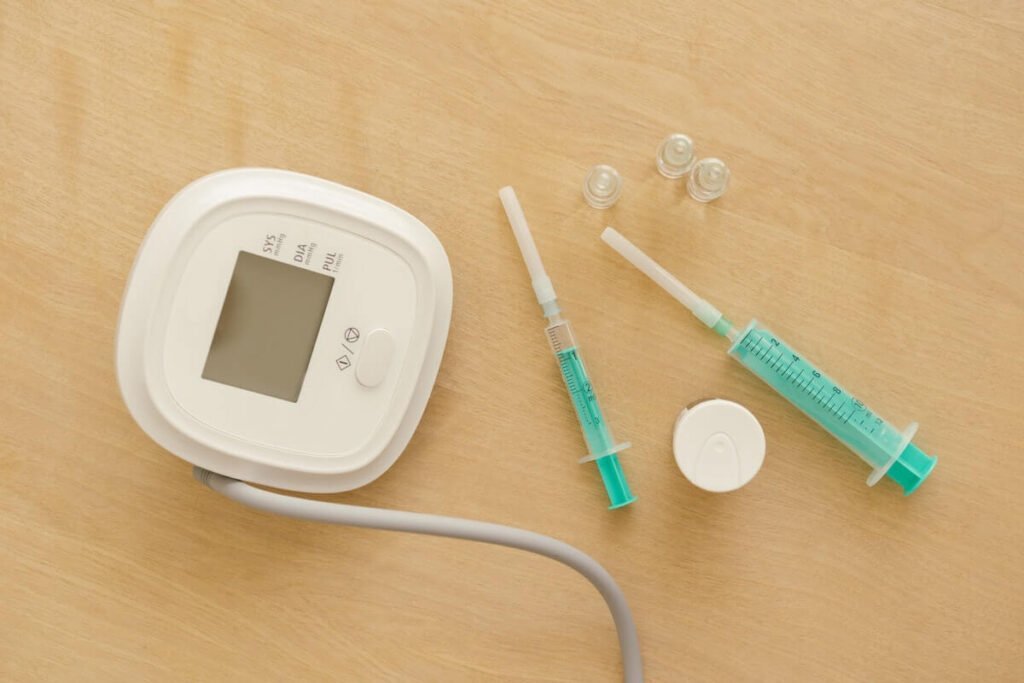Understanding Type 1 Diabetes
Any person with type 1 diabetes would understand that the crucial role insulin plays in maintaining healthy blood sugar levels. Insulin is a hormone that regulates how much glucose (sugar) is taken into cells to be used as fuel. High blood sugar occurs when glucose (sugar) accumulates in the bloodstream and is not removed by insulin. Type 1 diabetes can be treated with insulin, and this article will explain the different kinds of insulin, how to inject it, and any potential side effects.
Types of insulin
Insulin is available in a variety of formulations for people with type 1 diabetes. Rapid-acting, short-acting, intermediate-acting, and long-acting insulin are the four main types.
Fast-acting insulin is typically administered before a meal in order to help maintain healthy blood sugar levels after eating. This type of insulin typically takes 10–15 minutes to begin working and lasts for 2-4 hours.
Rapid-acting insulin
One of the four types of insulin used to treat type 1 diabetes is rapid-acting insulin. Its name implies that it does what it promises: reduces blood sugar levels rapidly after a meal. Most fast-acting insulin is effective within an hour of administration and begins working within 15 minutes. This makes it an excellent option for those who require prompt regulation of blood sugar.
When compared to longer-acting insulin, rapid-acting insulin offers greater meal-planning flexibility because it can be taken either before or after a meal. While effective, its effects wear off more quickly than those of other types, potentially necessitating additional injections throughout the day to maintain stable blood sugar levels.
When it comes to managing type 1 diabetes, rapid-acting insulin can be a helpful tool. However, it should only be used under the supervision of a medical expert, who can determine the appropriate dosage and administration schedule for the individual patient.
Short-acting insulin
Rapidly reducing blood sugar levels, short-acting insulin (or regular insulin) is a form of insulin. It is commonly used before meals to mitigate the rise in blood sugar that follows digestion. When combined with longer-acting insulin, short-acting insulin can help keep blood sugar levels stable throughout the day.
Short-acting insulins, in contrast to long-acting insulins, have a rapid onset of action and no peak effect. Typically, 30 minutes is all it takes before you feel the effects, and the full effect lasts another couple of hours. This makes them perfect for preventing the blood sugar from skyrocketing after a meal.
In addition to regular human insulin, rapid-acting analogues such as Humalog and Novolog are also available as short-acting insulins. People with Type 1 diabetes should consult with their healthcare providers to find out which form of rapid-acting insulin is ideal for them.

Intermediate-Acting Insulin
Intermediate-acting insulin, as opposed to fast-acting or short-acting insulin, takes longer to begin working but remains effective for a longer period of time. Once injected, the effects of this form of insulin can be felt within 1 to 2 hours and continue for 12 to 24 hours. In this capacity, it serves as the “background insulin” necessary to keep blood sugar levels stable all day and night.
NPH (Neutral Protamine Hagedorn) and Lente are two types of insulin that fall into the intermediate-acting category. While NPH is cloudy and requires mixing before injection, Lente is transparent and has a moderately short half-life. These insulins are typically injected twice daily, with the dosage adjusted according to the patient’s blood sugar levels.
However, there are some risks associated with using intermediate-acting insulin, including hypoglycemia (low blood sugar) and hyperglycemia (high blood sugar) (high blood sugar). People with type 1 diabetes who use this insulin need to keep a close eye on their blood sugar levels and work closely with their healthcare team to make any necessary adjustments.
Long-Acting Insulin
People with type 1 diabetes cannot function without long-acting insulin. It’s a type of insulin that releases its effects gradually over time. Long-acting insulin, in contrast to rapid-acting insulin, maintains a steady stream of insulin throughout the day and night, allowing for more precise control of blood sugar levels. Because of this, it’s great for preventing a drop in blood sugar levels in the three hours between meals and while sleeping.
Several brands of long-acting insulin are commercially available. Lantus, Levemir, and Toujeo are just a few examples. Time to onset and length of effect vary considerably between types. Which one you use is determined by your own specific requirements and preferences.
You can inject long-acting insulin or use an insulin pump to give it to your body. It’s best to inject it deep into the subcutaneous fat of the thighs, stomach, or upper arms. Insulin pumps allow for the subcutaneous administration of long-acting insulin via a constant infusion.
People with type 1 diabetes can benefit from long-acting insulin because it helps them maintain a healthy glucose level all day long, even when other treatments aren’t effective.
Insulin Delivery Methods
People with type 1 diabetes can choose from a variety of insulin administration methods.
AN INSULIN PEN
Injecting insulin into the subcutaneous fat tissue under the skin with a syringe or insulin pen is the most common method.
PUMP FOR INSULIN
Insulin pumps, which deliver insulin continuously through a catheter in the skin, are another option. The user has control over the basal rate and bolus doses when using this method.
INHALED INSULIN
Inhaled insulin is another delivery method that has recently gained FDA approval. It’s possible that this approach is currently unavailable in other countries. Powdered insulin can be inhaled using a device similar to an asthma inhaler. Some people who have trouble self-injecting or who prefer not to use an insulin pump may find this method more practical.
Ultimately, factors such as one’s work schedule, level of physical activity, and frequency of checking glucose levels will determine which method of delivery is the best fit. It’s crucial to have an open dialogue with your healthcare provider about your diabetes management options.
Potential Side Effects
The potential side effects of insulin treatment for type 1 diabetes are a major cause for concern. Hypoglycemia, or low blood sugar, is a side effect of insulin therapy that can be life-threatening if left untreated. Dizziness, confusion, sweating, and trembling are all symptoms of low blood sugar, or hypoglycemia.
Insulin therapy may also cause patients to gain weight. Insulin prevents the body from using glucose from food as fuel, instead causing it to be stored as fat. Even if you maintain a healthy diet and exercise routine, you may still gain weight. Working closely with your doctor to develop a treatment plan that complements your way of life can help reduce the likelihood of this happening.
Finally, insulin therapy has been linked to allergic reactions in a small percentage of patients. This may occur immediately following the injection, or it may take place later as your body develops antibodies to the drug. Itching, injection-site swelling, respiratory difficulties, and fainting are all possible symptoms of an allergic reaction. Get medical help immediately if you experience any of these after starting insulin therapy.
FAQ
1. How does insulin therapy work for type 1 diabetes?
Insulin therapy is when insulin is injected into the body. This is usually done with a syringe or an insulin pump. This helps regulate blood sugar levels in individuals with type 1 diabetes who cannot produce enough insulin on their own. The goal of treatment is to keep blood sugar levels within a healthy range and prevent complications associated with diabetes.
2. What types of insulin are available?
There are several types of insulin available, including rapid-acting, short-acting, intermediate-acting, and long-acting insulins. Rapid-acting insulins start working within minutes and last for a few hours, while long-acting insulins can last up to 24 hours.
3. How often do I need to take insulin injections?
The frequency of injections depends on the individual’s needs and the type of insulin being used. Some people may require multiple daily injections, while others may only need one injection per day.
4. Are there any side effects associated with insulin therapy?
Common side effects include low blood sugar (hypoglycemia), weight gain, and injection site reactions such as redness or swelling. It is important to monitor blood sugar levels regularly and work closely with a healthcare provider to adjust medication doses as needed.
5. Can I stop taking insulin once my blood sugar levels improve?
It is possible to stop taking insulin once your blood sugar levels are under control because the medication has done its job and helped you achieve better control.

